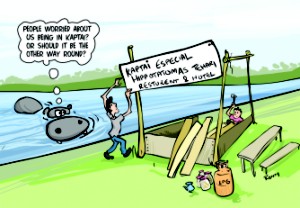| Home - Back Issues - The Team - Contact Us |
 |
| Volume 10 |Issue 24 | June 24, 2011 | |
|
|
Postscript Hippo-critical Ideas AASHA MEHREEN AMIN
So when our well-informed yet misinformed state minister announces that a few hippopotami can be brought in from Africa to reside in Kaptai Lake to bring in more tourists, one cannot help but wonder at the sanity of such a proposal. Environmentalists and wildlife experts, the killjoys that they are, are stunned at this jaw-dropping announcement. The state minister's bright idea came to him while visiting Kenya (the natural home of many a hippo) and saw hippos sitting in small lakes and revelling in human attention. His logic is simple enough: hippos in the Lake will add a new species to our biodiversity. This may threaten the local species pointed out environmentalists. Well then, said the minister, the hippo can be kept in a corner of the lake. Perhaps we can give the travelling hippo or hippos a guidebook on how to share a lake with other species. A section on the dos and don'ts of the local culture can also be included: don't eat or squash the fish; don't charge at the natives, don't intimidate the fishermen and let them fish, get used to the local diet as home food (African grass, that too a hundred pounds of it every day) will not be available. But how much will these big 11 feet long and five feet tall beauties cost? A mere TK 40 lakh for a pair, says the minister's personal assistant. This he adds can easily be forked out from the immense Climate Change funds - the government's and that of its development partners. Sounds perfectly reasonable right? The only thing is that forty lakh taka is a lot of money and wouldn't it make more sense to leave it for the Aila victims and other humans who will be left homeless due to climate change? Before the activist-minded people get started with human chains against the invasion of the Kaptai Lake by foreign animals, let them take note that nothing has been decided yet. We hope. We are banking on the good sense of the government to ignore such ideas and remember that there is plenty of local wildlife to save and protect. They can use whatever funds available to protect, say, the Royal Bengal Tigers instead. It is sad but true, that we have this strange notion that anything foreign must be good. Perhaps it is part of our colonial legacy. But it is this lack of basic common sense that has allowed foreign eucalyptus trees in many forests to replace the indigenous species, sucking out all the water from the ground and African catfish in the ponds to cannibalise the local fish and sometimes bite off a human finger or two. In the present situation therefore, regardless of the cuteness factor, it would be best to just leave both the hippos and the Kaptai Lake alone.
Copyright
(R) thedailystar.net 2011 |
 H
H